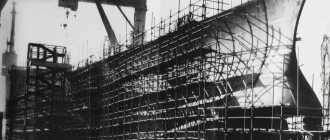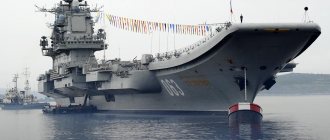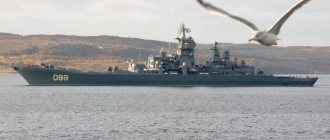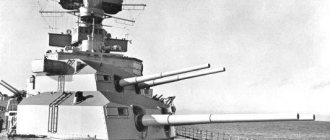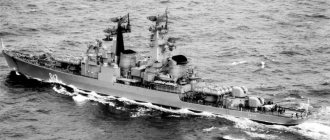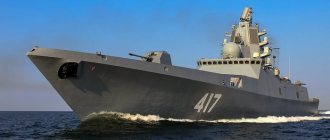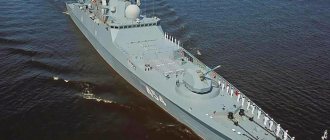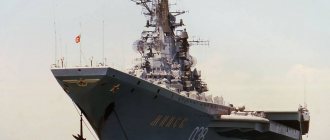Photos
Project 11437
In the mid-1980s, the Nevskoye Design Bureau developed a project for a heavy aircraft-carrying cruiser with a nuclear power plant, steam catapults on the corner deck, a take-off ramp and three aircraft lifts.
- The lead ship of Project 11437, Ulyanovsk, was laid down on November 25, 1988. It was to become the flagship of the Soviet Navy and the first of four cruisers of the same type. After the collapse of the USSR in 1991, production was discontinued, and the ship was dismantled on the slipway in 1992.
Tactical and Technical Characteristics
3.1 Main characteristics
- Displacement: 45,390 tons maximum, 44,490 tons full, 38,970 tons normal, 33,440 tons standard.
- Length: 242.86 m at the waterline, 273.08 m deep.
- Beam: 31.0 m at the waterline, 52.9 m deep.
- Height: 60.30 m overall. Side height (from the vertical line): 24.96 m at the bow, 21.63 m amidships, 21.61 m at the stern.
- Draft: average (from OP): with normal displacement 8.47 m, with full displacement 9.42 m. Maximum: 11.52 m.
- Armor: rolled steel, hull duplication with “dry compartments”
- Engines: boiler-turbine, four-shaft, 4 GTZA TV-12-3, 8 KVN 98/64 boilers.
- Power: steam turbines: 4 × 45,000 hp, turbogenerators: 6 × 1500 kW, diesel generators: 4 × 1500 kW.
- Propulsion: 4, four-blade.
- Travel speed: 14.05 knots of economic speed, 18.32 knots of combat economic speed, 29 knots of full speed, 32.5 knots of maximum speed.
- Cruising range: at a speed of 18 knots - 7590 miles.
- Navigation autonomy: 30 days.
- Crew: staff: 1615 people, with headquarters: 1665 people, air group: 430 people.
3.2 Armament
- Radar weapons: general detection radar: 1 × radar with phased array "Mars-Passat", 1 × radar MR-710M-1 "Fregat-M1", 2 × radar MR-360 "Podkat", 3 × radar "Vaigach". Aviation control system: 1 × “Resistor-K4”, 2 × “Lawn”.
- Electronic weapons: BIUS "Lesorub-434", communications complex "Buran", SJSC "Polynom", electronic warfare and electronic warfare complex "Kantata-M", electronic warfare equipment "Pogonya" and "Kaskad-U".
- Artillery: 2 × 1 AK-100 (600 rounds).
- Anti-aircraft artillery: 8 × 6 AK-630 (48,000 rounds).
- Missile armament: 6 × 2 Basalt anti-ship missile launchers, 4 × 6 Kinzhal air defense missile systems (192 missiles).
- Anti-submarine weapons: 2 × 10 RBU-12000 (60 bombs)
- Aviation group: 36 airplanes and helicopters. According to the project: 14 × Yak-41M VTOL aircraft, 6 × Yak-38M VTOL aircraft, 10 × Ka-27PL, 2 × Ka-27PS, 4 × Ka-27RLD.
Project 1123 (code "Condor")
They were classified as anti-submarine cruisers and served as a base for an air group of 14 Ka-25 helicopters of various modifications. The ships of this project had a standard displacement of 11,100 tons (full - 15,280 tons), length of 189 meters, width of 34 meters.
They were equipped with a two-shaft boiler-turbine power plant with a total capacity of 90 thousand horsepower and reached a speed of up to 29 knots. The cruising range was 6,000 nautical miles (11,100 km), and the navigation endurance was 15 days. Crew - 541 people, of which 131 are officers.
The ship's armament included launchers for the Shtorm anti-aircraft missile system (ammunition - 96 missiles), Vikhr anti-submarine systems (9 missiles) and RBU-6000 rocket launchers (240 bombs), 533 mm torpedo tubes, AK artillery mounts -725 caliber 57 mm.
- The lead ship "Moskva" was laid down under serial number 701 on December 15, 1962, launched on January 14, 1965, and accepted into the fleet on December 25, 1967. Expelled from the fleet on November 7, 1996. Subsequently cut into metal in India.
- The first production ship "Leningrad" under serial number 702 was laid down on July 31, 1966, launched on July 31, 1966, entered the fleet on April 22, 1969, and left it on December 5, 1992. In 1995, cut into metal in India.
- The second production ship (serial number 703, project 1123M/11233, with a length increased by 12 meters) was planned for laying down in 1968, but construction was cancelled.
Story
4.1 Construction
In February 1978, the aircraft carrier Admiral of the Fleet of the Soviet Union Gorshkov of Project 1143.4, first named Baku, was added to the lists of the USSR Navy. Before 1979, on the slipway of the Black Sea Shipyard, freed from the launched Novorossiysk aircraft carrier, work began on the construction of the Baku. Assembly was carried out from ready-made sections weighing up to 150 tons. The cruiser was launched on March 31 (launching weight was approximately 19,000 tons), after which it underwent completion near the wall of the plant. Due to failures in the delivery of equipment and changes being made, the aircraft carrier began mooring tests only on June 2, 1986. On December 4, the ship sailed to Sevastopol, where it docked for two weeks.
4.2 Tests
In January 1987, sea trials began on the Baku. After them, the aircraft carrier was supplemented with a fairing mounted on the sponson, as well as a device that equalized air flows above the flight deck. State tests began in April, when the main strike complex was fired. In December, the ship was enlisted in the USSR Navy.
4.3 Combat service
In April 1988, the cruiser was enlisted in the permanent readiness forces, and the following month they began to prepare it for combat service. The air group included SPARK Yak-38U, search and rescue Ka-25PS, Yak-38M attack aircraft, Ka-27PL anti-submarine helicopters and Ka-27PS target designators. It was decided to combine the first combat service with the transition to the point of permanent deployment. In June, the aircraft carrier sailed from Sevastopol to the Mediterranean Sea. There, the cruiser in particular observed the US nuclear-powered aircraft carrier Dwight Eisenhower. In December of the same year, the cruiser arrived in Severomorsk, where she was assigned to the 170th brigade of anti-submarine ships of the 7th OpEsk.
Then the cruiser no longer carried out long-range combat services, but combat training classes were not canceled. In 1989, the aircraft carrier participated three times in training to support amphibious landings; helicopters made 1,142 flights from it, and naval attack aircraft made 171 flights. In October of the following year, the ship received the name “Admiral of the Fleet of the Soviet Union Gorshkova”. In 1990, over 1,200 helicopter flights and 47 airplane flights took place. The following year, combat training activity decreased. Then helicopters, for example, made over 400 flights. In September-October, the Yak-141 carrier-based GDP fighter was tested on the aircraft carrier, which was expected to replace the decommissioned Yak-38 as the main carrier-based aircraft. When an accident occurred in early October, resulting in the loss of the aircraft, testing stopped and was not carried out further. A year later, development of the Yak-141 was cancelled.
In February 1992, in Murmansk, the aircraft carrier began to be repaired. In July, the Naval flag was lowered and St. Andrew's was raised.
4.4 Sale of the cruiser
Two years later, negotiations began with the Republic of India on the sale of the cruiser. In 1999, Admiral Gorshkov was transported by tug to Severodvinsk for modernization. All necessary documentation was signed in 2000, but the contract price was not precisely established until 2002. At the beginning of 2004, an agreement was signed under which $530 million was allocated for the supply of Ka-27 and Ka-31 naval anti-submarine helicopters and 16 MiG-29K fighter aircraft, as well as $974 million intended for the modernization and restoration of the aircraft carrier . Russia pledged to hand it over to India at the end of 2008. But India has suspended payments since early 2007, paying only about $450 million. Plus, this year the renovation was delayed due to lack of personnel. After the President of the Russian Federation D. Medvedev paid a visit to India, their authorities approved the start of negotiations on the new cost of modernizing the aircraft carrier.
In the summer of 2013, the aircraft carrier underwent sea trials in the White Sea, during which the operation of the boilers of the main power plant was checked in all modes. Then, in the Barents Sea, the cruiser underwent flight tests, in which helicopters and carrier-based aircraft participated, and the ship-plane system was also commissioned. In November, Admiral Gorshkov was transferred to India.
TWO VIEWS AT ONE PROBLEM
To sell or not to sell an aircraft carrier?
There was no consensus on this matter either in the State Duma, or in the government of the Russian Federation, or in the General Staff of the Navy. In 1996, State Duma deputies from the Republic of Karelia, whose capital Petrozavodsk patronized the Gorshkov, turned to the Ministry of Defense and the Government of the Russian Federation with a reasoned request to leave the TAVKR as part of the Russian Navy. First Deputy Commander-in-Chief of the Navy, Admiral Igor Kasatonov, in turn, sent a memo to Viktor Chernomyrdin, in which he convincingly argued for the need to jointly use the last two remaining aircraft carriers in Russia: the Admiral Kuznetsov - as a carrier of Su-27K fighters, the Admiral Gorshkov - as a ready-made helicopter carrier capable of protecting the Kuznetsov and other ships from attacks from under water.
But all requests and proposals were, as they say, shelved. And there was an equally compelling reason for this: Russia did not have the money to maintain the aircraft carrier.
Currently in the Russian Federation there is no enterprise designed for the construction of aircraft carriers, there is no technology, there is no system of agents and contractors, and finally, there are no funds to create giant ships. Russia, which considers itself a maritime power, is not able to modernize even one aircraft carrier, let alone build an aircraft carrier division.
Our American partners are convinced that an aircraft carrier should live several lives, undergoing repairs and modernization over a certain period of time. Overseas they believe that it is more economically profitable for the country to modernize old ships than to build new ones. In the United States they know how to count money. The oldest US aircraft carrier has been in active service for about 50 years. During this time, it underwent four modernizations.
Based not on the immediate situation in the Russian economy, but acting with the perspective in mind, the Gorshkov should be preserved for the Russian fleet. But, as Vladimir Chuvakin rightly noted in a conversation with me, an aircraft carrier is not a chicken; you can’t put it in the refrigerator.
Brief description of the design
The frigate's hull has a long forecastle, and a double bottom extends from the bow to the engine room. In order to reduce the likelihood of the ship being detected by enemy radars, its superstructure is made of carbon fiber-based composites. Such materials absorb radio waves well.
In other words, “Admiral Gorshkov” was built using “stealth” technologies.
The frigate's power plant is of a combined type. In it, a diesel engine and a gas turbine operate on each of the propeller shafts. The power of turbines is 27,500 hp, and diesel power is 5,200 hp. The total power of the entire installation reaches 65,000 hp. The vessel uses fixed pitch propellers. The frigate is equipped with pitch stabilizers. Seaworthiness, ultimately, should allow the Admiral Gorshkov to conduct combat operations even in a force five storm.
The frigate's main artillery caliber is a universal 130mm automatic cannon in the A-192 mount. The previous gun mount of a similar caliber - the AK-130 - had a mass of over 80 tons. This limited its use only to large ships - cruisers and destroyers. The weight of the A-192 installation is only 25 tons, and it can be installed even on small ships such as frigates.
The rate of fire reaches 30 rounds per minute, the cannon can hit ground and sea targets at ranges of up to 23 kilometers. When using the gun as an anti-aircraft gun, the reach is 18 kilometers in altitude.
Small-caliber artillery is represented by two Broadsword anti-aircraft installations, one per side. Each installation carries two six-barrel automatic guns GSh 6-30KD, the rate of fire of which is up to 10 thousand rounds per minute (in total). "Broadswords" hit air targets at altitudes of up to 3 kilometers.
The Admiral Gorshkov's missile weapons are located in the nose of the hull in universal vertical launch systems.
Two UVP ZS14U1 contain eight cells each, into which missiles for various purposes can be loaded. The Onyx medium-range anti-ship missile allows you to hit ships at ranges of up to 300 kilometers, the mass of the warhead is 300 kilograms. It is invisible to radar and is used on a fire-and-forget basis.
Another option is Kalibr cruise missiles. This missile is universal and, depending on the version, can be anti-ship, anti-submarine or tactical for hitting ground targets. The flight range is up to 300 kilometers (like the Onyx), the warhead can be penetrating or high-explosive fragmentation. Guidance – inertial and radar. Anti-submarine missiles carry a torpedo as a warhead.
Finally, in the future the frigate will be able to use Zircon missiles, which have not yet entered service. These anti-ship missiles are distinguished by extremely high (hypersonic) flight speeds. Re-equipping Russian ships with these missiles could, according to some estimates, reduce the role of aircraft carriers and force the development of new missile defense systems.
The air defense of the Admiral Gorshkov is provided, in addition to artillery, by the Redut missile system. Its launchers are also in the nose, in front of the ZS14U1. The ammunition capacity includes up to 32 long-range 9M96 missiles (launch range - up to 120 km) and up to 128 close-range missiles 9M100 (range - about 15 km).
The frigate is protected from enemy submarines by two quadruple “Packet-NK” installations.
They hit submarines with small-sized 324 mm torpedoes, and attacking torpedoes with M-15 rocket-propelled anti-torpedoes. The deck hangar of the Admiral Gorshkov accommodates the Ka-27 helicopter, traditional for the Russian fleet.
Russian developments
No aircraft-carrying ships were built in Russia. In the 2010s, the Krylov State Scientific Center (KGSC, St. Petersburg) developed a preliminary design of the multi-purpose heavy aircraft carrier "Storm" (project 23000, code "Lair") with a displacement of 100,000 tons, which would accommodate an air group of up to 90 aircraft and helicopters. A model of the ship was demonstrated in the summer of 2015 at the International Naval Show in St. Petersburg. General Director of the Nevsky Design Bureau Sergei Vlasov estimated the cost of building such a ship at 200-280 billion rubles.
In addition, the KGNTs and Nevsky Design Bureau are designing several types of landing helicopter-carrying dock ships (DVKD), these projects are coded “Priboy”, “Avalanche” and “Sperm Whale”.
Prospects, combat and service
The main thing you can expect from Admiral Gorshkov is trouble-free operation. Still, this is the first in a series that has no continuity with its predecessors. So, first of all, one must hope that he will not develop any serious “childhood diseases.” And that the main diesel engine, which managed to break down, will remain the biggest problem.
The frigate will most likely carry out patrol duty. Perhaps it will support the actions of ground troops with missile strikes (if they are not withdrawn from hot spots in the coming years).
And if Project 22350 ships are built in a large series, then they have every chance of becoming the main “workhorse” of the fleet (as the American destroyer Arleigh Burke is today). And frigates armed with Zircon missiles will have the opportunity to attack any, even the largest, enemy ships. And heavy cruisers will no longer be needed to destroy aircraft carriers.
Project 22350 frigates have opened a new, long-awaited page in the history of the Russian fleet.
Even the best Soviet-built ships have long been in need of replacement - and now it has come. The Navy began to accept new ships, created taking into account modern requirements.
The activities of Admiral Sergei Gorshkov as Commander-in-Chief are currently assessed differently. There is an opinion that instead of building nuclear cruisers, the Soviet Union should have paid more attention to aircraft carriers. But there is a certain symbolism in the fact that the name of the admiral was assigned to a small ship, but powerfully armed and quite capable (in the future) of coping with the role of a counterweight to aircraft carriers.
